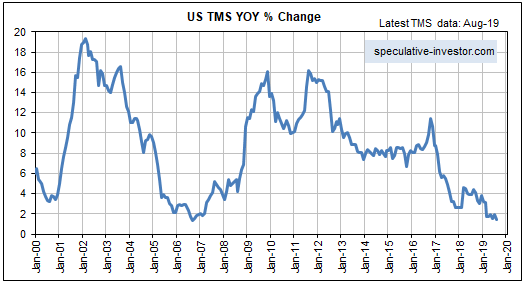[This post is an excerpt from a recent TSI commentary]
Once an equity bear market is well underway it runs its course, regardless of the Fed’s actions. For example, the Fed started cutting interest rates in January of 2001, but the bear market that began in March of 2000 continued until October-2002. For another example, the Fed started cutting interest rates in September-2007, but a bear market commenced in October-2007 and continued until March-2009 despite numerous Fed actions designed to halt the price decline. On this basis it can be argued that the Fed’s introduction of a new asset monetisation program roughly one week ago won’t prevent the stock market from rolling over into a major bearish trend. However, there is a good reason to think that it could be different this time (dangerous words, we know) and that the Fed’s new money-pumping scheme will prove to be game-changer.
The reason to think that it could be different this time is that in one respect it definitely is different. We are referring to the fact that although the Fed started cutting interest rates in the early parts of the last two cyclical bear markets (2000-2002 and 2007-2009), it didn’t begin to directly add new money to the financial markets until the S&P500 Index had been trending downward with conviction for about 12 months.
To further explain, when the Fed’s targeted interest rates follow market interest rates downward, which is what tends to happen during at least the first half of an economic downturn, the official rate cuts do not add any liquidity to the financial system. It’s only after the Fed begins to pump new money into the financial markets that its actions have the potential to support asset prices.
During the last two bear markets, by the time the Fed started to pump money it was too late to avoid a massive price decline. This time around, however, the Fed has introduced a fairly aggressive money-pumping program while the S&P500 is very close to its all-time high and seemingly still in a bullish trend.
The Fed has emphasised that the new asset monetisation program should not be called “QE” because it does not constitute a shift in monetary policy. Technically this is correct, but in a way it’s worse than a shift towards easier monetary policy. The Fed’s new program is actually a thinly-disguised attempt to help the Primary Dealers absorb an increasing supply of US Treasury debt. To put it another way, the Fed is now monetising assets for the purpose of financing the US federal government, albeit in a surreptitious manner.
This relates to a point we made in a recent blog post. The point is that when the central bank is perceived to be financing the government, as opposed to implementing monetary policy to achieve economic (non-political) objectives such as “price stability”, there is a heightened risk that a large decline in monetary confidence will be set in motion. One effect of this would be an increase in what most people think of as “inflation”.
Summing up, it’s possible that the Fed’s new asset monetisation program will extend the current cycle (prolong the equity bull market) and lead to more “price inflation” than earlier programs.
 Print This Post
Print This Post

